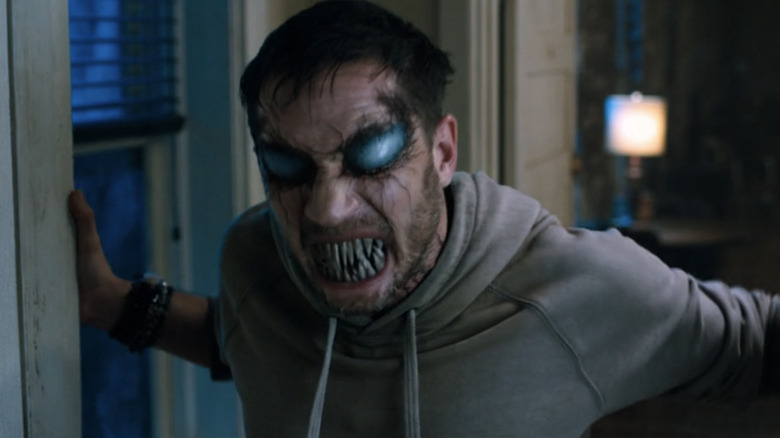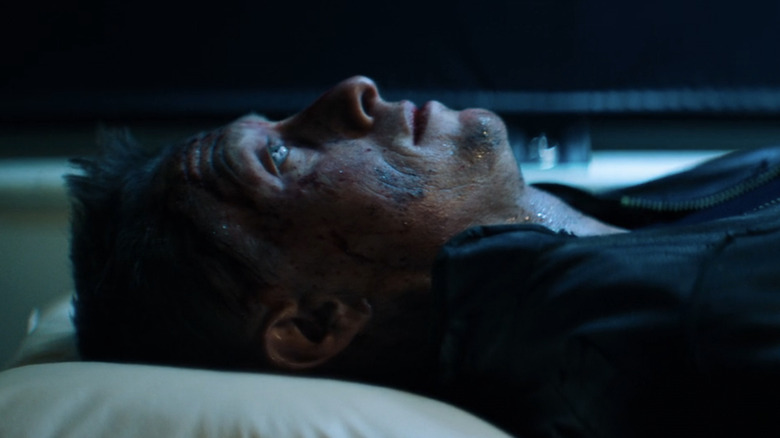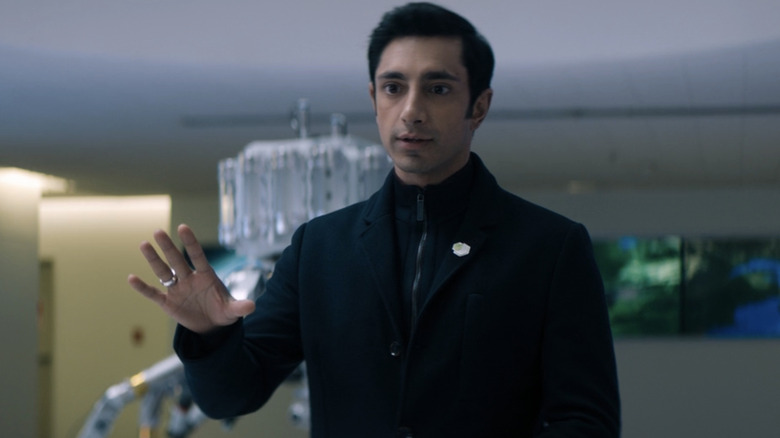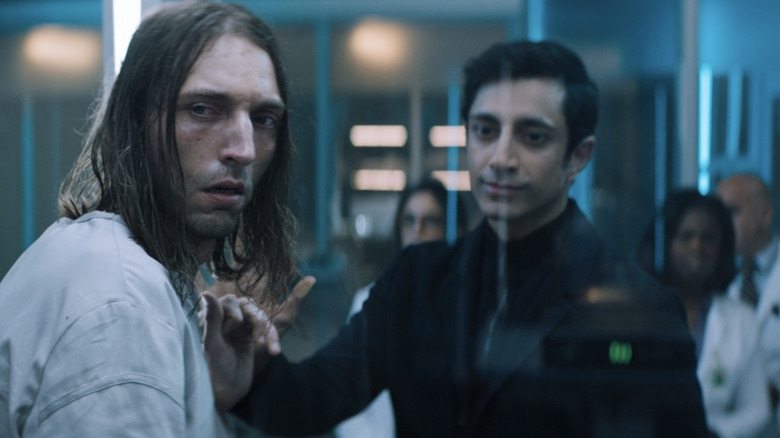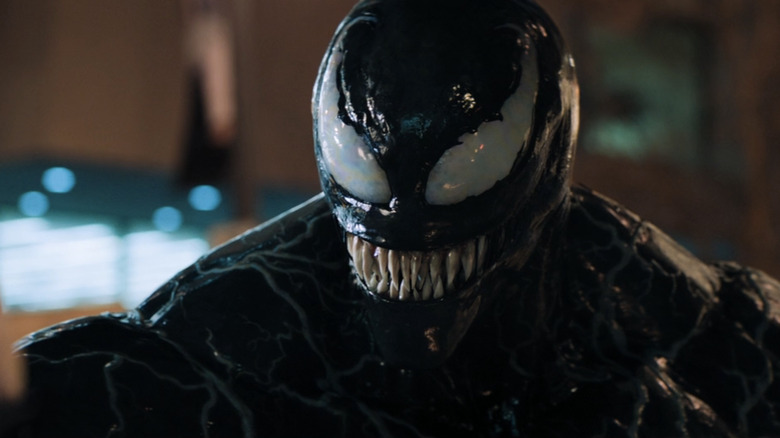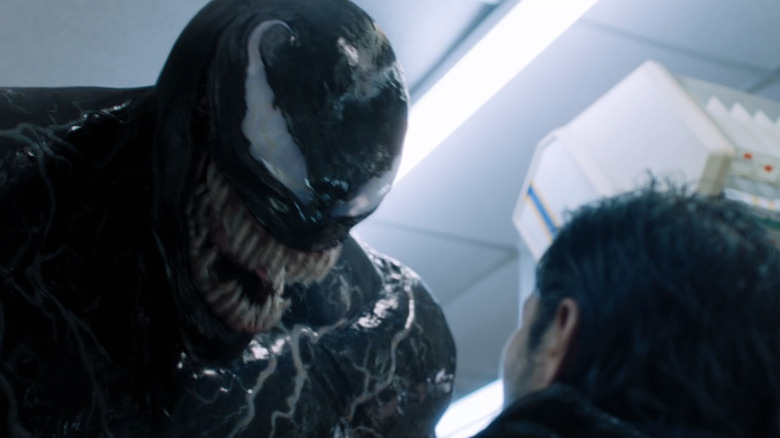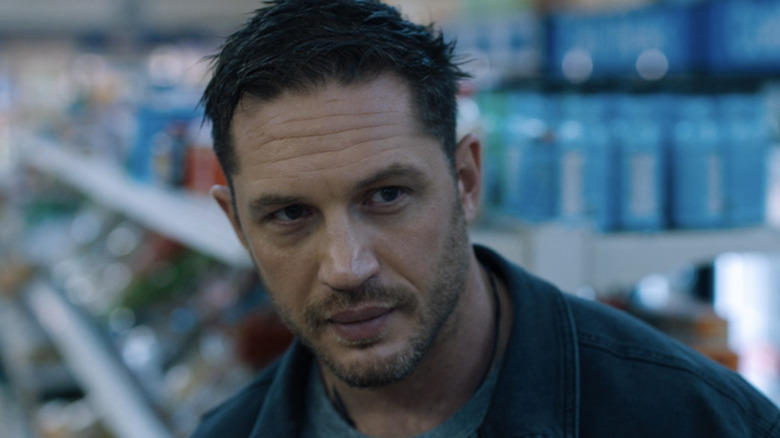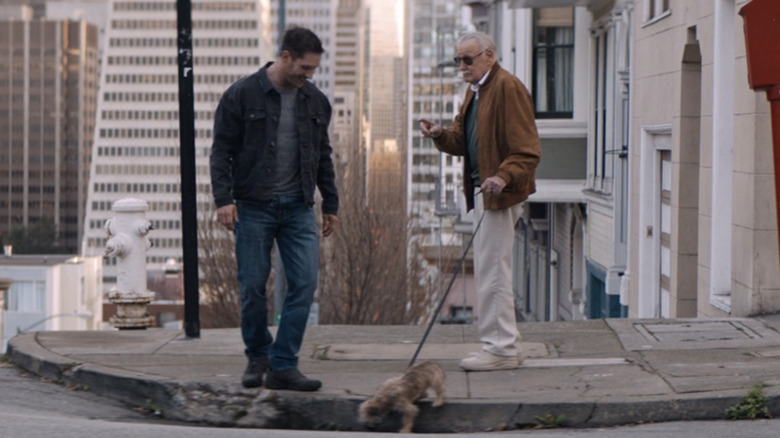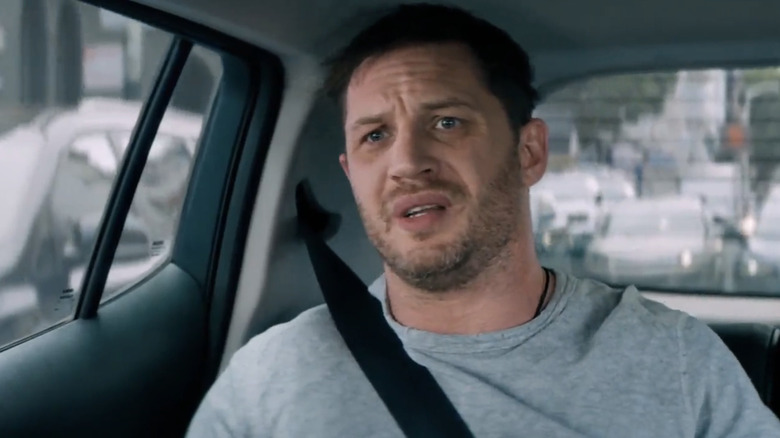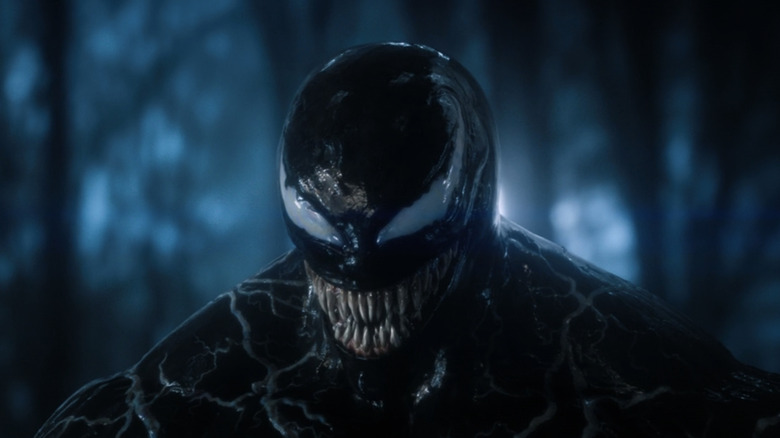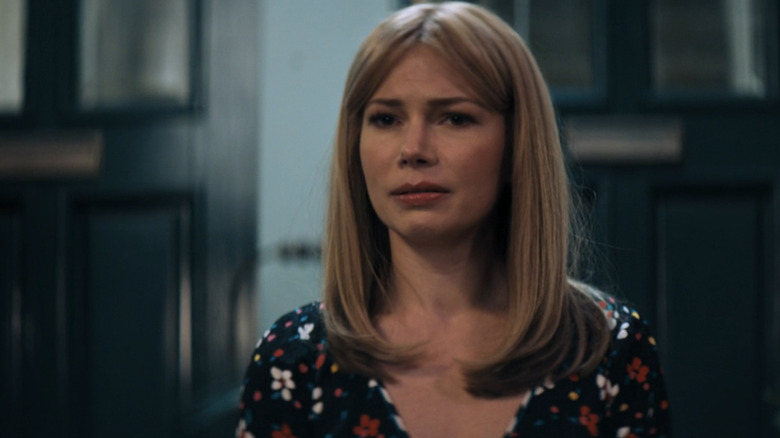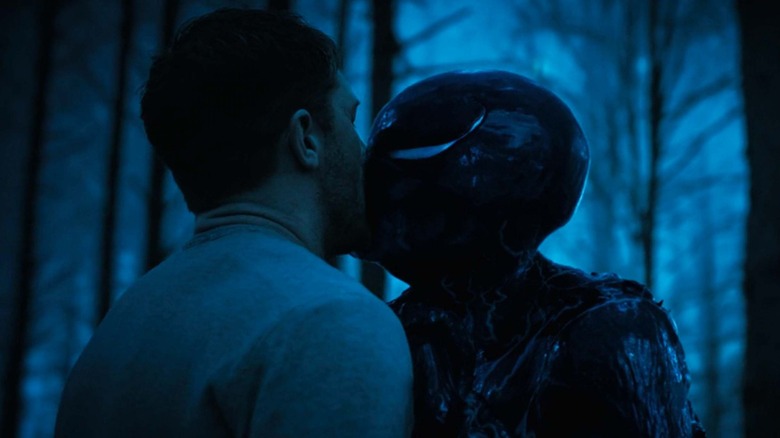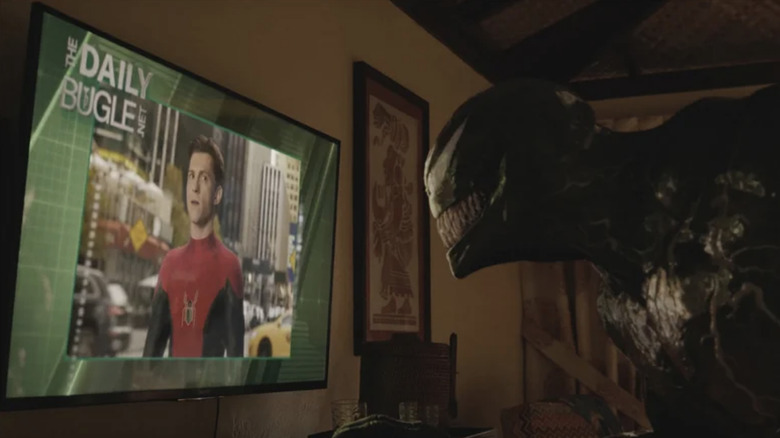We Rewatched Venom And Here's What We Noticed
As the linchpin for Sony's (Spider-Man-less) Spider-Man Universe, "Venom" picked up where Marc Webb's "Amazing Spider-Man" films left off thematically by expanding the Spidey side of the Marvel universe on the big screen. With Tom Hardy in the lead role of Eddie Brock/Venom, this 2018 film set the tone for the entire SSU going forward. Arguably the most successful entry in the lackluster franchise, "Venom" proved that the Lethal Protector could exist apart from the spectacular wall-crawler, who had since been drafted into the Marvel Cinematic Universe. The gamble more than paid off as "Venom" raked in over $850 million at the box-officeagainst a $110-116 million budget.
Reimagining the Venom character as "The Odd Couple" with a superhero twist — inspired by Marvel's beloved "Venom: Lethal Protector" comic series from the 1990s — was no doubt a novel way of reintroducing audiences to the character after his previous (and largely hated) outing in "Spider-Man 3," back when Topher Grace played the villain. Without Spider-Man, Venom was free to be a hero, and he certainly took our breath away. Following the 2021 sequel "Venom: Let There Be Carnage," the "Venom" trilogy is set to wind down this fall with "Venom: The Last Dance," which promises to show our hero on the run from not just one, but both of their respective worlds. In preparation, let's break down some of the finest details you might have missed the first time you watched "Venom."
A Jameson survives the crash
"Venom" literally hits the ground running. The opening crash of the Life Foundation's space shuttle leaves no survivors save the four sample alien lifeforms and the one lucky astronaut who finds himself possessed by one of Marvel's alien symbiotes. From their control center in San Francisco, Carlton Drake (Riz Ahmed) and his team oversee the wreckage in Malaysia, and note that the one surviving astronaut is a man named Jameson. This quick reference is paid off later in the film's end credits, where we learn that the character's full name is actually J.J. Jameson III, played by actor Chris O'Hara. If this feels like an intentional expansion into the Spider-Man mythos, you're right.
In the original Marvel comics, John Jameson is the son of none other than J. Jonah Jameson, Peter Parker's boss at the Daily Bugle. Jameson is indeed an astronaut, and while he's not often associated with Venom in the comics, there is one other iteration of the symbiote's earthly origins that connects the pair. In the "Spider-Man: The Animated Series" three-parter "The Alien Costume," it's John Jameson who brings the Venom symbiote to Earth after a space mission gone wrong. When the ship crashes, the symbiote escapes while Spider-Man rescues the crew. Little does Jameson know, but his adventures in outer space change the entire course of Spider-Man's life and serve as the basis for many future Venom origins.
The Life Foundation has an unintended double meaning
While fans of the "Venom: Lethal Protector" comic series will undoubtedly recognize the Life Foundation as a major antagonist in that book's initial run, there's also an unintentional double meaning we can draw from the name. Carlton Drake's desire to explore the unknown universe and find life forms out among the stars feels awfully reminiscent of the 2017 film "Life." Now, this science fiction/horror flick is not connected to "Venom" in any official capacity, despite both projects being produced by Sony, but there was a time during the film's production when fans thought "Life" was a direct, secret prequel to "Venom."
The fact that the trailers for "Life" included shots from "Spider-Man 3" (which featured the Venom character), along with the initial premise of finding a goo-like alien lifeform that slowly begins eating those around it, caused many to theorize that "Life" and "Venom" were connected. Paired with the fact that "Life" screenwriters Paul Wernick and Rhett Reese had previously written a draft of "Venom," the connections seemed obvious. The duo would later joke that "Life" actually was an unintentional "Venom" prequel, but it was all in jest. Still, the fact that "Venom," released a year after "Life" first hit theaters, features a villainous organization named the Life Foundation almost makes us wish this fan theory were true.
Drake's desire to cure cancer calls back to a specific Marvel comic
When Eddie interviews Carlton Drake early on in the film, he passingly mentions that Drake, at only 19 years old, had discovered a gene therapy that tripled the life expectancy of those suffering from pancreatic cancer. It's a small line that establishes Drake's supposedly noble intentions with his vast wealth and resources. It also gives Eddie an opportunity to discuss Drake's questionable experiments. While Drake began the Life Foundation as a means to reach for the stars, there's no doubt that he sees the potential in the symbiotes' healing properties as well, which can do everything from resetting and healing broken bones to (quite possibly) resurrecting the dead.
In the comics, there are quite a few strong connections between the Venom character and curing cancer. In Brian Michael Bendis' "Ultimate Spider-Man" run, a revised origin for an alternate universe Venom reveals that Peter Parker and Eddie Brock's fathers had been working on a cure for cancer when they first developed the alien symbiote. Likewise, in the mainstream Marvel Universe, there was a period in the early 2000s when Eddie had cancer himself, which the Venom symbiote apparently fed on in order to increase its power. However, the 2018 "Venom" series would retcon that diagnosis as a lie that the symbiote told Eddie to keep the pair from separating ... Talk about messed up.
There are sly references to Venom's creators
Unsurprisingly, "Venom" contains a fair amount of references to the original Marvel comics. From Eddie's sympathies for his homeless neighbors to specific lines pulled directly from the source material ("Eyes, Lungs, Pancreas. So many snacks, so little time."), the 2018 film does a fine job at giving fans plenty of nods to the world of Marvel Comics. But even the most eagle-eyed viewers might have missed a few, including some quick references to Venom's creators. Did you catch the name of the law firm that Michelle Williams' Anne Weying works for? Michelinie and McFarlane is a direct reference to writer David Michelinie and artist Todd McFarlane, who together invented Venom and his signature appearance.
But that's not the only comic book callback "Venom" throws out there. The Schueller Building is mentioned during Eddie/Venom's escape from the Life Foundation's security team, but who is Schueller? Well, Randy Schueller was a Marvel fan from Illinois who wrote to the comic company in the early 1980s with an idea for a black stealth costume for Spider-Man. While his origins for the suit were a bit different than the eventual alien symbiote that Marvel came up with, then Editor-in-Chief Jim Shooter paid Schueller for the idea and eventually Venom was born. Ironically, the Venom character wasn't Schueller's cup of tea. "I was never a fan of the costume-turned-villain idea," Schueller wrote for CBR in 2007, though he remained thrilled that his idea was used at all.
Venom's craving for chocolate makes more sense now
"Venom" wastes no time reminding us that the titular symbiote has a consistent craving for human brains, and as disturbing as it is, there's actually a reason. It's not just because aliens like the squishiness of brains in particular, but rather because there's a specific chemical component that the symbiote craves. Throughout the picture, Venom is constantly talking about eating people, and actually does take a few heads along the way. But at the end of the film, Eddie makes Venom swear not to eat any more human beings — or, at the very least, not the good ones. The symbiote agrees, of course, only to devour a thug who attempts to scare some "protection money" out of Mrs. Chen (Peggy Lu).
Anyone who's seen "Venom: Let There Be Carnage" knows that Venom goes on to develop a love for chocolate in lieu of brains, but that idea is first noted here at the end of the first film. Why chocolate? Because both the human brain and chocolate give off a chemical called phenethylamine, which can improve one's mood and attention, among other uses. Stangely, there's comic book precedent for this too. At the end of the four-part comic arc "Venom: The Hunger," Eddie Brock discovers that Venom can survive just as well off chocolate as he can human flesh. It's "more socially acceptable," Eddie explains in "Venom: Sign of the Boss" #1. "And pleasant."
Venom calls Eddie a loser because he's one too
Throughout all of "Venom," the alien symbiote constantly berates Eddie for being a loser. He's lost his fiancé, he's lost his job, he's lost his apartment, and now, with Venom riding shotgun, he's slowly losing his sanity too. Venom never wastes an opportunity to put Eddie down, and continually forces him to submit to his will. But there's a moment during the film's climax that offers us a different perspective on Venom's behavior. While abuse should never be tolerated, it seems that Venom's name-calling is a direct result of his own inferiority complex within his species.
Unlike Carlton Drake's symbiote Riot (or even Carnage in the sequel), Venom can't create physical weapons. Instead, he relies on his tendrils or makeshift shields in combat. Riot notes in their final battle that Venom has a "strong host," implying that Eddie is the only reason that Venom could successfully engage in combat with him. It's clear that, on his homeworld, Venom was somewhat subservient to the other symbiotes in charge, and his decision to leave his people behind and live on Earth instead (which happens pretty quickly) is never a struggle for him. Some Marvel comics have noted the untold truth about Venom: he's an outcast among his own race, the Klyntar, an idea "Venom" ran with as well.
Stan Lee's cameo hints at the Multiverse
Stan Lee's unforgettable cameos are some of the best parts of any Marvel movie. He's played every kind of role from fictionalized versions of himself to actual comic book characters brought to life. His brief appearance in 2018's "Venom" is no less grand, as he tells both Eddie and Venom not to give up on Anne. It's a touching moment, but it also raises some questions within the context of the wider live-action Marvel universe. What's particularly interesting is that he seems to know that both Eddie Brock and Venom exist in the same body — we just don't know how.
Stan Lee is seen talking to a group of Watchers in the 2017 MCU film "Guardians of the Galaxy, Vol. 2," implying that he's an informant for the multiversal beings. But the MCU connections don't stop there. Eddie and Venom eventually hop over to the MCU themselves at the end of "Venom: Let There Be Carnage," which ties directly into the post-credits scene from "Spider-Man: No Way Home." Maybe Stan Lee's "Venom" cameo was a multiversal precursor? Given Lee's connection to the Watchers, it doesn't seem like that far of a stretch, and may even offer a better explanation for how he knows Venom is with Eddie at that moment. After all, even Venom seems surprised that Lee knows he's hiding just below the surface.
A deleted scene better explains Eddie's career
There were a few deleted scenes from "Venom" left on the cutting room floor, but only one that provides a clearer insight into Eddie Brock's life and career. In the "Ride to the Hospital" deleted scene, Eddie and Venom argue in a rideshare on their way to meet with Anne and her new boyfriend Dr. Dan Lewis (Reid Scott). In the heat of the argument, Eddie lets it slip that as a boy he used to steal the other kids' toys, but not because he wanted them for himself. No, Eddie wanted the credit of finding the lost toys when he would eventually give them back. While this seems like a small thing, it actually helps us to better contextualize his actions at the beginning of the film.
In light of this revelation, Eddie's career choice seems more selfishly motivated than it does heroic. We see this especially when Eddie uses Anne's confidential legal reports as the basis for his accusations against Carlton Drake, getting both Anne and Eddie fired. It's no wonder Anne breaks off their engagement, leaving Eddie to clean up his own mess. Unlike when he was a kid, Eddie can't just fix things by righting his initial wrong. He has to actively change by putting others before himself — a lesson that takes him most of the film to figure out.
Tom Hardy's son was very critical of Venom
It must be hard to play a comic book character when you have a kid back home who loves the source material. Tom Hardy found that out the hard way while making "Venom," as his son is a major fan of the original Marvel comics. "He was extremely critical of everything, in a good way," Hardy told SyFy ahead of the film's release. "As someone who has read lots of Marvel comics, not just 'Venom,' he's very specific about what needs to be done, 'because it's right.'" In contrast, Hardy explained that, as an adult, he believes it was important to make compromises with the material in order to produce new opportunities that didn't necessarily exist in the comic books.
"[You] can't make stuff up with my son," Hardy continued. "If it's not in the comic book, it just doesn't exist then." Despite that, Hardy claims that his son loved the finished product, though he admitted that his son still has strong opinions on how the character should be handled in the future. It makes us wonder how many of the ideas for "Let There Be Carnage" and the upcoming "The Last Dance" might have stemmed from Hardy's Venom conversations at home.
There's a real-life reason Anne doesn't get back with Eddie
When Anne breaks off her engagement with Eddie at the beginning of "Venom," it doesn't come as a surprise. As she says, he intentionally used her and got her fired from her dream job as a result. Taking back agency in her own life, Anne moves on from Eddie, gets her own place, starts dating a nice doctor, and finds work elsewhere. But although Eddie does find his way back into Anne's life, "Venom" doesn't end with the hero getting the girl, and that was by design.
"When we started making 'Venom,' I said to the director, Ruben [Fleischer], that I know I can't exactly wear a #MeToo T-shirt, but that's the feeling that I want in this movie," Michelle Williams told The Hollywood Reporter. The "Manchester by the Sea" and "The Greatest Showman" star made it clear from the get-go that she wanted Anne to have the type of agency that other superhero female leads often lack, which no doubt led to Anne becoming She-Venom for her pivotal role in the third act. "I just wanted the story to have constant nods to the male-female interplay that is happening now," Williams explained, noting also that "Venom" was both a "new" and "fun" experience.
There is a rom-com reimagining of Venom
After "Venom" was released, many fans took to the interwebs to talk all about "SymBrock," the romantic pairing between Eddie and his alien "parasite." The line "I am Venom and you are mine" from the film was interpreted by some in a more romantic context rather than in the threatening one it was offered in, and it wasn't long before fan art of the pair was dispersed. Soon after, Sony got wise to the free publicity and re-cut the "Venom" trailer in preparation for the home video release that December.
Called the "Official 'Rom-Com' Trailer," the clip played into the fan expectations following the film's theatrical release, mirroring many of the romantic comedy cliches from the early 2000s and 2010s. Fans would react the same way to the 2021 sequel, "Venom: Let There Be Carnage," which was deemed a "break-up movie" by audiences. From what we've seen so far of the third installment, "Venom: The Last Dance" — which boasts a tagline of "'Til death do they part" — the "Venom" saga will continue play on these same subtle (or maybe not so subtle) romantic undertones going forward.
Venom still works without Spider-Man
For many, the idea that Venom would get his own feature film entirely independent of Spider-Man seemed unfathomable. Venom's origins are so distinctly tied to Spidey, after all, that it's hard to imagine how Eddie Brock and the symbiote could be united sans Peter Parker. Well, "Venom" gave us a pretty good answer, and offered a unique take on the character that forever separated him from Spider-Man (despite the studio still calling it Sony's Spider-Man Universe). But if you thought something was missing from "Venom," you weren't alone. Rumors were disseminated online that Tom Holland was on the "Venom" set filming a potential cameo appearance, but director Ruben Fleischer set the record straight.
"I think we're hoping to build to that, but, no, at no point was Tom Holland going to be in this movie," Fleischer told IGN. Nevertheless, "Venom" has since connected to both the "Spider-Verse" series of animated films as well as the MCU, with Venom even seeing Holland's Spidey unmasked on television. Whether a variant of Holland's Spider-Man character exists within the convoluted SSU timeline or not, the fact remains that Eddie Brock and Venom are doing just fine on their own. Sure, a Spider-Man showdown would be a blast, but Venom has made a name for himself beyond his webslinging nemesis.
